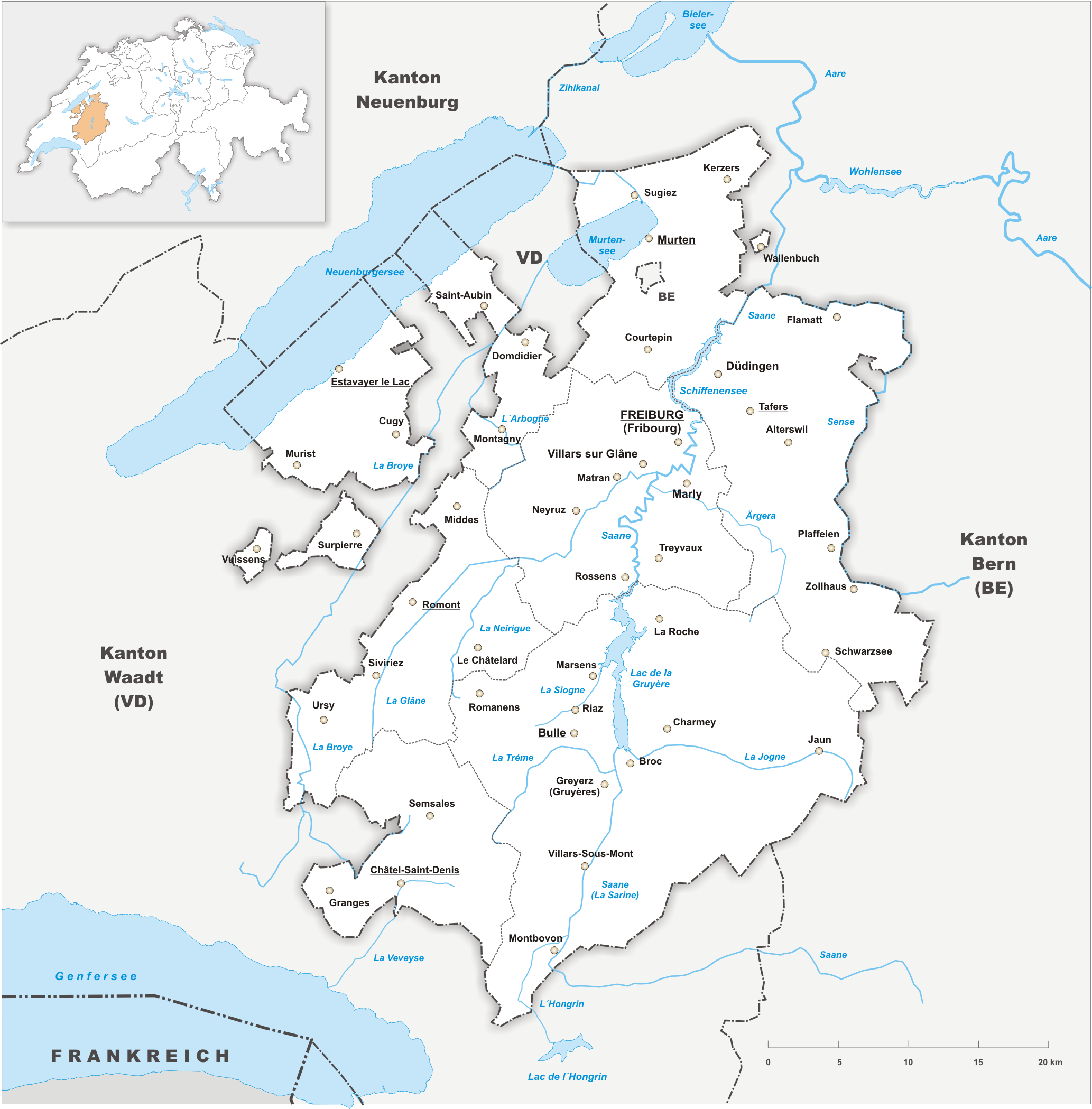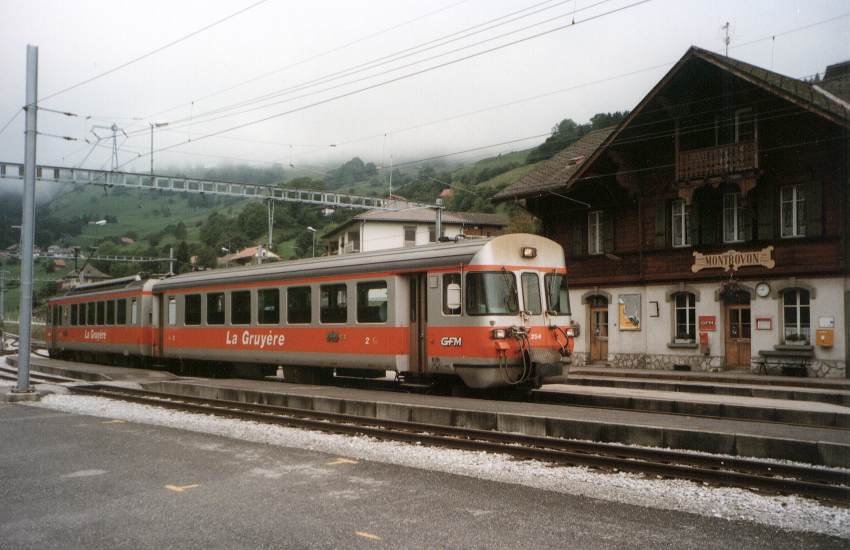|
Bulle–Broc Railway Line
The Bulle–Broc railway line is a railway line in the canton of Fribourg, Switzerland. It runs from to . It was built in 1912 by the Chemins de fer électriques de la Gruyère (CEG) as a branch from the Palézieux–Bulle–Montbovon railway line. Both lines were . Transports publics Fribourgeois (TPF) closed the line in 2021 for rebuilding as a standard gauge line, which will permit through operation over the Bulle–Romont railway line. History The Chemins de fer électriques de la Gruyère constructed the branch line in 1912, with the section from Bulle to Les Marches opening on 29 January and from Les Marches to Broc on 24 June. In 1942, the CEG merged with two other companies to form the Chemins de fer fribourgeois Gruyère–Fribourg–Morat (GFM). The GFM, in turn, became the Transports publics Fribourgeois The Transports Publics Fribourgeois (TPF) is a renaming of the former Chemins de fer Fribourgeois Gruyère-Fribourg-Morat when the municipal Transport en comm ... [...More Info...] [...Related Items...] OR: [Wikipedia] [Google] [Baidu] |
Transports Publics Fribourgeois
The Transports Publics Fribourgeois (TPF) is a renaming of the former Chemins de fer Fribourgeois Gruyère-Fribourg-Morat when the municipal Transport en commun de Fribourg (TF) was absorbed in 2000. Lines The company is a railway operator with both narrow and standard gauge lines centred in the town of Bulle. The main line of the narrow gauge network runs from Palézieux railway station (at Palézieux-Gare), on the SBB main line from Bern to Lausanne, via Châtel-St-Denis and Bulle to Montbovon. The short Bulle - Broc branch, which leaves this line between Bulle and La Tour-de-Trême, serves the nearby Nestlé (formerly Cailler) chocolate factory. The company also operates two standard-gauge lines, between Bulle and Romont and Fribourg - Ins via Murten/Morat. Trains on the latter route have been extended and now operate a regular interval service Fribourg - Murten - Ins - Neuchatel, taking them on to BLS tracks (Ins - Neuchatel). The Palézieux - Montbovon line was ope ... [...More Info...] [...Related Items...] OR: [Wikipedia] [Google] [Baidu] |
Canton Of Fribourg
The canton of Fribourg, also canton of Freiburg (french: Canton de Fribourg ; german: Kanton Freiburg ; frp, Canton de Fribôrg rm, Chantun Friburg it, Canton Friburgo) is located in western Switzerland. The canton is bilingual, with French spoken by more than two thirds of the citizens and German by a little more than a quarter. Both are official languages in the canton. The canton takes its name from its capital city of Fribourg. History On the shores of Lake Neuchâtel and Lake Morat significant traces of prehistoric settlements have been unearthed. The canton of Fribourg joined the Swiss Confederation in 1481. The area is made up of lands acquired by the capital Fribourg. The present extent was reached in 1803 when Murten (Morat) was acquired. The canton of Fribourg joined the separatist league of Catholic cantons in 1846 ( Sonderbund). The following year, its troops surrendered to the federal army. Geography The canton is bounded to the west by Lake Neuchâtel, to ... [...More Info...] [...Related Items...] OR: [Wikipedia] [Google] [Baidu] |
Chemins De Fer électriques De La Gruyère
The Chemins de fer électriques de la Gruyère (CEG) was the name finally adopted by the Chemin de fer Châtel-St-Denis-Bulle-Montbovon (CBM) before operation started. (The 1903 federal rolling stock statistics already showed the company as CEG). In 1907 it was enlarged by the amalgamation of the Chemin de fer Châtel-St-Denis-Palézieux (CP). To this system was added a short branch from Bulle to Broc, which opened in 1912. The company operated a system of just 48.2 km with a main line from Montbovon, the junction with the MOB, to Palézieux, on the SBB-CFF-FFS line between Bern and Lausanne. The Broc branch made up the total distance. Two standard gauge operations joined in a further amalgamation on 1 January 1942 when together they formed the Chemins de fer Fribourgeois Gruyère-Fribourg-Morat. Between 1929 and 1932, the CEG also operated the Fribourg–Farvagny trolleybus system The Fribourg–Farvagny trolleybus system (french: Train sans voie de Fribourg–Farvagny ... [...More Info...] [...Related Items...] OR: [Wikipedia] [Google] [Baidu] |
Palézieux–Bulle–Montbovon Railway Line
The Palézieux–Bulle–Montbovon railway line is a railway line in the canton of Fribourg, Switzerland. It runs from to . The line is owned and operated by Transports publics Fribourgeois (TPF). History The first section between and opened on 29 April 1901. It was built by the Chemin de fer Châtel-St-Denis–Palézieux (CP). The Chemins de fer électriques de la Gruyère (CEG) built another line east from Châtel-St-Denis to Vaudens, opening on 23 July 1903. At the same time, the CEG opened a line north from to La Tour-de-Trême. The CEG closed the gap in 1904, completing sections between Vaudens and on 14 July and Bulle and La Tour-de-Trême on 21 September. The CEG acquired the CP on 20 December 1907. In 1942, the CEG merged with two other companies to form the Chemins de fer fribourgeois Gruyère–Fribourg–Morat (GFM). The GFM, in turn, became the Transports publics Fribourgeois (TPF) in 2000. Route The line begins in Palézieux, where it terminates acro ... [...More Info...] [...Related Items...] OR: [Wikipedia] [Google] [Baidu] |
Bulle–Romont Railway Line
The Bulle–Romont railway line is a standard gauge railway line in the canton of Fribourg, Switzerland. It runs from to . The line is owned and operated by Transports publics Fribourgeois (TPF). History The Chemin de fer Bulle–Romont Chemin or Le Chemin may refer to: Arts and media * ''Le chemin'' (Emmanuel Moire album), 2013 album by French singer Emmanuel Moire * ''Le chemin'' (Kyo album), 2003 album by French band Kyo ** "Le Chemin" (song), title song from same-titled Kyo ... (BR) opened the line between Bulle and Romont on 1 July 1868. The line was electrified on 8 May 1946. In 1942, the BR merged with two other companies to form the Chemins de fer fribourgeois Gruyère–Fribourg–Morat (GFM). The GFM, in turn, became the Transports publics Fribourgeois (TPF) in 2000. Notes References * Railway lines in Switzerland Transport in the canton of Fribourg Railway lines opened in 1868 15 kV AC railway electrification {{DEFAULTSORT:Bulle-Romont railwa ... [...More Info...] [...Related Items...] OR: [Wikipedia] [Google] [Baidu] |
Chemins De Fer Fribourgeois Gruyère–Fribourg–Morat
The Chemins de fer fribourgeois Gruyère–Fribourg–Morat (GFM) was a railway company in Switzerland. It was established with the merger in 1942 of two standard gauge and one gauge railways running mainly within the Swiss canton of Fribourg. It was officially called the ''Compagnie des Chemins de fer fribourgeois'' beim Eidg. Amt für das Handelsregister ("Fribourg Railway Company"). The company also operated numerous regional buses in the same area. After a merger with Fribourg city transport, the company was renamed Transports publics fribourgeois/Freiburgische Verkehrsbetriebe (TPF). The company was created on 1 January 1942 from the merger of metre-gauge Chemins de fer électriques de la Gruyère ("Electric Railways of the Gruyère"; CEG), the standard-gauge Fribourg-Ins Railway (''Chemin de fer Fribourg–Morat–Anet''; FMA) and the also standard gauge Bulle-Romont Railway (''Bulle-Romont-Bahn''; BR). On 1 January 2000, the GFM merged with the ''Transport en c ... [...More Info...] [...Related Items...] OR: [Wikipedia] [Google] [Baidu] |
Track Gauge Conversion
Gauge conversion is the changing of one railway track gauge (the distance between the running rails) to another. Sleepers If tracks are converted to a narrower gauge, the existing sleepers (ties) may be used. However, replacement is required if the conversion is to a wider gauge. Some sleepers may be long enough to accommodate the fittings of both existing and alternative gauges. Wooden sleepers are suitable for conversion because they can be drilled for the repositioned rail spikes. Being difficult to drill, concrete sleepers are less suitable for conversion. Concrete sleepers may be cast with alternative gauge fittings in place, an example being those used during the conversion of the Melbourne–Adelaide railway from to . Steel sleepers may have alternative gauge fittings cast at production, may be drilled for new fittings or may be welded with new fittings. Structures Conversion from a narrow to a wider gauge may require enlargement of the structure gauge of the brid ... [...More Info...] [...Related Items...] OR: [Wikipedia] [Google] [Baidu] |
Railway Lines In Switzerland
Rail transport (also known as train transport) is a means of transport that transfers passengers and goods on wheeled vehicles running on rails, which are incorporated in tracks. In contrast to road transport, where the vehicles run on a prepared flat surface, rail vehicles ( rolling stock) are directionally guided by the tracks on which they run. Tracks usually consist of steel rails, installed on sleepers (ties) set in ballast, on which the rolling stock, usually fitted with metal wheels, moves. Other variations are also possible, such as "slab track", in which the rails are fastened to a concrete foundation resting on a prepared subsurface. Rolling stock in a rail transport system generally encounters lower frictional resistance than rubber-tyred road vehicles, so passenger and freight cars (carriages and wagons) can be coupled into longer trains. The operation is carried out by a railway company, providing transport between train stations or freight customer faci ... [...More Info...] [...Related Items...] OR: [Wikipedia] [Google] [Baidu] |
Metre Gauge Railways In Switzerland
The metre (British spelling) or meter (American spelling; see spelling differences) (from the French unit , from the Greek noun , "measure"), symbol m, is the primary unit of length in the International System of Units (SI), though its prefixed forms are also used relatively frequently. The metre was originally defined in 1793 as one ten-millionth of the distance from the equator to the North Pole along a great circle, so the Earth's circumference is approximately km. In 1799, the metre was redefined in terms of a prototype metre bar (the actual bar used was changed in 1889). In 1960, the metre was redefined in terms of a certain number of wavelengths of a certain emission line of krypton-86. The current definition was adopted in 1983 and modified slightly in 2002 to clarify that the metre is a measure of proper length. From 1983 until 2019, the metre was formally defined as the length of the path travelled by light in a vacuum in of a second. After the 2019 redefiniti ... [...More Info...] [...Related Items...] OR: [Wikipedia] [Google] [Baidu] |
Transport In The Canton Of Fribourg
Transport (in British English), or transportation (in American English), is the intentional movement of humans, animals, and goods from one location to another. Modes of transport include air, land ( rail and road), water, cable, pipeline, and space. The field can be divided into infrastructure, vehicles, and operations. Transport enables human trade, which is essential for the development of civilizations. Transport infrastructure consists of both fixed installations, including roads, railways, airways, waterways, canals, and pipelines, and terminals such as airports, railway stations, bus stations, warehouses, trucking terminals, refueling depots (including fueling docks and fuel stations), and seaports. Terminals may be used both for interchange of passengers and cargo and for maintenance. Means of transport are any of the different kinds of transport facilities used to carry people or cargo. They may include vehicles, riding animals, and pack animals. Vehicles ma ... [...More Info...] [...Related Items...] OR: [Wikipedia] [Google] [Baidu] |




